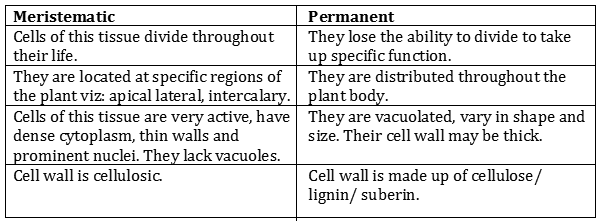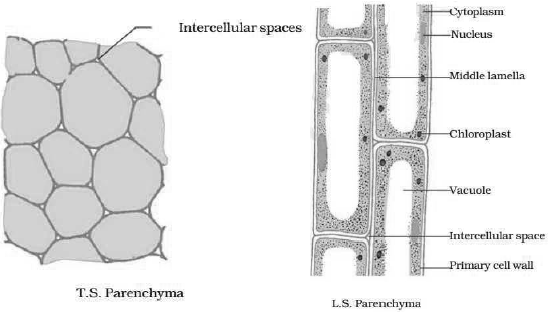Read and download free pdf of CBSE Class 9 Biology Tissues Worksheet Set C. Students and teachers of Class 9 Science can get free printable Worksheets for Class 9 Science Chapter 6 Tissues in PDF format prepared as per the latest syllabus and examination pattern in your schools. Class 9 students should practice questions and answers given here for Science in Class 9 which will help them to improve your knowledge of all important chapters and its topics. Students should also download free pdf of Class 9 Science Worksheets prepared by teachers as per the latest Science books and syllabus issued this academic year and solve important problems with solutions on daily basis to get more score in school exams and tests
Worksheet for Class 9 Science Chapter 6 Tissues
Class 9 Science students should download to the following Chapter 6 Tissues Class 9 worksheet in PDF. This test paper with questions and answers for Class 9 will be very useful for exams and help you to score good marks
Class 9 Science Worksheet for Chapter 6 Tissues
Fill in the blanks
Question: Cork cells possess __________ on their walls that makes them impervious to gases and water.
Answer: Suberin
Question: __________ have tubular cells with perforated walls and are living in nature.
Answer: Sieve tubes
Question: Bone possesses a hard matrix composed of __________ and __________.
Answer: Calcium and phosphorus
Question: Lining of blood vessels is made up of __________.
Answer: Squamous epithelium
Question: Lining of small intestine is made up of __________.
Answer: Columnar epithelium
Question: Lining of kidney tubules is made up of __________.
Answer: Cuboidal epithelium
Question: Epithelial cells with cilia are found in __________ of our body.
Answer: Respiratory tract
Question: __________ are forms of complex tissue.
Answer: Xylem and phloem
Question: __________ have guard cells.
Answer: Stomata
Question: Cells of cork contain a chemical called __________.
Answer: Suberin
Question: Husk of coconut is made of __________ tissue.
Answer: Sclerenchyma
Question: __________ gives flexibility in plants.
Answer: Collenchyma
Question: __________ and __________ are both conducting tissues.
Answer: Xylem; phloem
Question: Xylem transports __________ and __________ from soil.
Answer: Water; minerals
Question: Phloem transports __________ from __________ to other parts of the plant.
Answer: Food; leaf
Question: Animals of colder regions and fishes of cold water have thicker layer of subcutaneous fat. Describe why?
Answer: Fat acts as subcutaneous insulation of body for thermoregulation.
Question: Differentiate the following activities on the basis of voluntary (V) or involuntary (IV) muscles.
(a) Jumping of frog
(b) Pumping of the heart
(c) Writing with hand
(d) Movement of chocolate in your intestine
Answer: (a)—V, (b)—IV, (c)—V, (d) —IV
Question: (a) Differentiate between meristematic and permanent tissues in plants.
Answer:

Question: Define the process of differentiation.
Answer: The loss of ability to divide by taking up a permanent shape, size and function is called differentiation.
Question: Name any two simple and two complex permanent tissues in plants.
Answer: Simple: Parenchyma/collenchyma/sclerenchyma Complex: Phloem/xylem.
Question: Match the column (A) with the column (B)

Answer: —(v); b—(iv); c—(iii); d—(i); e—(ii); f—(vi);
Question: Match the column (A) with the column (B)

Answer: a—(i); b—(ii); c—(iv); d—(iii); e—(v);
Question: Write true (T) or false (F)
(a) Epithelial tissue is protective tissue in animal body.
(b) The lining of blood vessels, lung alveoli and kidney tubules are all made up of epithelial tissue.
(c) Epithelial cells have a lot of intercellular spaces.
(d) Epithelial layer is permeable layer.
(e) Epithelial layer does not allow regulation of materials between body and external environment.
Answer: (a)—T, (b)—T, (c)—F, (d) —T, (e)—F
Question: Name the different components of xylem and draw a living component?
Answer: Xylem consists of tracheids, vessels, xylem parenchyma and xylem fibres.

Question: Draw and identify different elements of phloem.
Answer: Sieve tubes, companion cells, phloem fibres and phloem parenchyma.

Question: Why is epidermis important for the plants?
Answer: Epidermis is important for plants due to the following reasons
(i) it gives protection
(ii) helps in gaseous exchange
(iii) checks water loss
(iv) root hairs arising from epidermis helps in absorption of water and minerals.
Question: Differentiate between voluntary and involuntary muscles. Give one example of each type.
Answer:

Question: List the characteristics of cork. How are they formed? Mention their role.
Answer: Characteristics
a) – Cells of cork are dead at maturity
– These cells are compactly arranged
– Cells do not possess intercellular spaces.
– Cells possess a chemical substances suberin in their walls
– They are several layers thick.
b) As plants grow older, a strip of secondary meristem replaces the epidermis of the stem.
Cells cut on the outer side by this meristem are called cork.
c) They are protective in function for older stem/twigs/branches. They are impervious to gases and water.
Question: Which structure protects the plant body against the invasion of parasites?
Answer: Epidermis having thick cuticle and waxy substances to prevent the invasion of parasites.
Question: Differentiate between sclerenchyma and parenchyma tissues. Draw well labelled diagram.
Answer:



Question: If a potted plant is covered with a glass jar, water vapours appear on the wall of glass jar. Explain why?
Answer: Transpiration takes place through stomata. Water vapour comes out of leaves during transpiration. When a potted plant is covered with a glass jar, water vapour (coming out becomes of transpiration) condenses on the wall of glass jar and hence it appears as fine droplets.
Question: Describe the structure and function of different types of epithelial tissues. Draw diagram of each type of epithelial tissue.
Answer: Epithelial tissues are the covering or protective tissues in the animal body. Epithelium covers most organs and cavities within the body and keep different body systems separate. The skin, the lining of the mouth, the lining of blood vessels, lung alveoli and kidney tubules are all made of epithelial tissue. Epithelial tissue cells are tightly packed and form a continuous sheet. They have only a small amount of cementing material.
between them and almost no intercellular spaces. The permeability of the cells of various epithelia play an important role in regulating the exchange of materials between the body and the external environment and also between different parts of the body. Regardless of the type, all epithelia are usually separated from the underlying tissue by an extracellular fibrous basement membrane.
Epithelial tissues are of following types— (1) Simple squamous epithelium (2) Stratified squamous epithelium (3) Columnar epithelium, and (4) Cubodial epithelium. These tissues differ in structure that correlate with their unique functions. For example, in cells lining blood vessels or lung alveoli, where transportation of substances occurs through a selectively permeable surface, there is a simple flat kind of epithelium. This is called the simple squamous epithelium. Simple squamous epithelial cells are extremely thin and flat and form a delicate lining. The skin, oesophagus and the lining of the mouth are also covered with squamous epithelium.
Skin epithelial cells are arranged in many layers to prevent wear and tear. Since, they are arranged in a pattern of layers, the epithelium is called stratified squamous epithelium. Where absorption and secretion occur, as in the inner lining of the intestine, tall epithelial cells are present. This columnar epithelium facilitates movement across the epithelial barrier. In the respiratory tract, the columnar epithelial tissue also has cilia, which are hairlike projections on the outer surfaces of epithelial cells. These cilia can move, and their movement pushes the mucus forward to clear it. This type of epithelium is thus ciliated columnar epithelium.
Cuboidal epithelium forms the lining of kidney tubules and ducts of salivary glands, where it provides mechanical support. Epithelial cells often acquire additional specialisation as gland cells, which can secrete substances at the epithelial surface. Sometimes a portion of the epithelial tissue folds inward, and a multicellular gland is formed. This is glandular epithelium.

Question: Draw well labelled diagrams of various types of muscles found in human body.
Answer:


Question: Water hyacinth float on water surface. Explain.
Answer: A special type of parenchyma; called aernchyma is present in water hyacinth. This tissue
has air-filled spaces inside. Due to this, water hyacinth floats on water surface.
Question: Why are xylem and phloem called complex tissues? How are they different from one other?
Answer: Both xylem and phloem consist of more than one type of cells, which coordinate to perform a common function.

| CBSE Class 9 Chemistry Matter In Our Surrounding Worksheet Set A |
| CBSE Class 9 Chemistry Matter In Our Surrounding Worksheet Set B |
| CBSE Class 9 Chemistry Is Matter Around Us Pure Worksheet Set A |
| CBSE Class 9 Chemistry Is Matter Around Us Pure Worksheet Set B |
| CBSE Class 9 Physics Motion Worksheet Set A |
| CBSE Class 9 Physics Motion Worksheet Set B |
| CBSE Class 9 Physics Gravitation Worksheet Set A |
| CBSE Class 9 Physics Gravitation Worksheet Set B |
| CBSE Class 9 Physics Work And Energy Worksheet Set A |
| CBSE Class 9 Physics Work And Energy Worksheet Set B |
| CBSE Class 9 Physics Sound Worksheet Set A |
| CBSE Class 9 Physics Sound Worksheet Set B |
| CBSE Class 9 Physics Sound Worksheet Set C |
| CBSE Class 9 Biology Why Do We Fall Ill Worksheet Set A |
| CBSE Class 9 Biology Why Do We Fall Ill Worksheet Set B |
| CBSE Class 9 Biology Why Do We Fall Ill Worksheet Set C |
| CBSE Class 9 Biology Natural Resources Worksheet Set A |
| CBSE Class 9 Biology Natural Resources Worksheet Set B |
| CBSE Class 9 Biology Natural Resources Worksheet Set C |
Worksheet for CBSE Science Class 9 Chapter 6 Tissues
We hope students liked the above worksheet for Chapter 6 Tissues designed as per the latest syllabus for Class 9 Science released by CBSE. Students of Class 9 should download in Pdf format and practice the questions and solutions given in the above worksheet for Class 9 Science on a daily basis. All the latest worksheets with answers have been developed for Science by referring to the most important and regularly asked topics that the students should learn and practice to get better scores in their class tests and examinations. Expert teachers of studiestoday have referred to the NCERT book for Class 9 Science to develop the Science Class 9 worksheet. After solving the questions given in the worksheet which have been developed as per the latest course books also refer to the NCERT solutions for Class 9 Science designed by our teachers. We have also provided a lot of MCQ questions for Class 9 Science in the worksheet so that you can solve questions relating to all topics given in each chapter.
You can download the CBSE Printable worksheets for Class 9 Science Chapter 6 Tissues for latest session from StudiesToday.com
There is no charge for the Printable worksheets for Class 9 CBSE Science Chapter 6 Tissues you can download everything free
Yes, studiestoday.com provides all latest NCERT Chapter 6 Tissues Class 9 Science test sheets with answers based on the latest books for the current academic session
CBSE Class 9 Science Chapter 6 Tissues worksheets cover all topics as per the latest syllabus for current academic year.
Regular practice with Class 9 Science worksheets can help you understand all concepts better, you can identify weak areas, and improve your speed and accuracy.

